News
The Mauritius 2020 Island Swim for Conservation
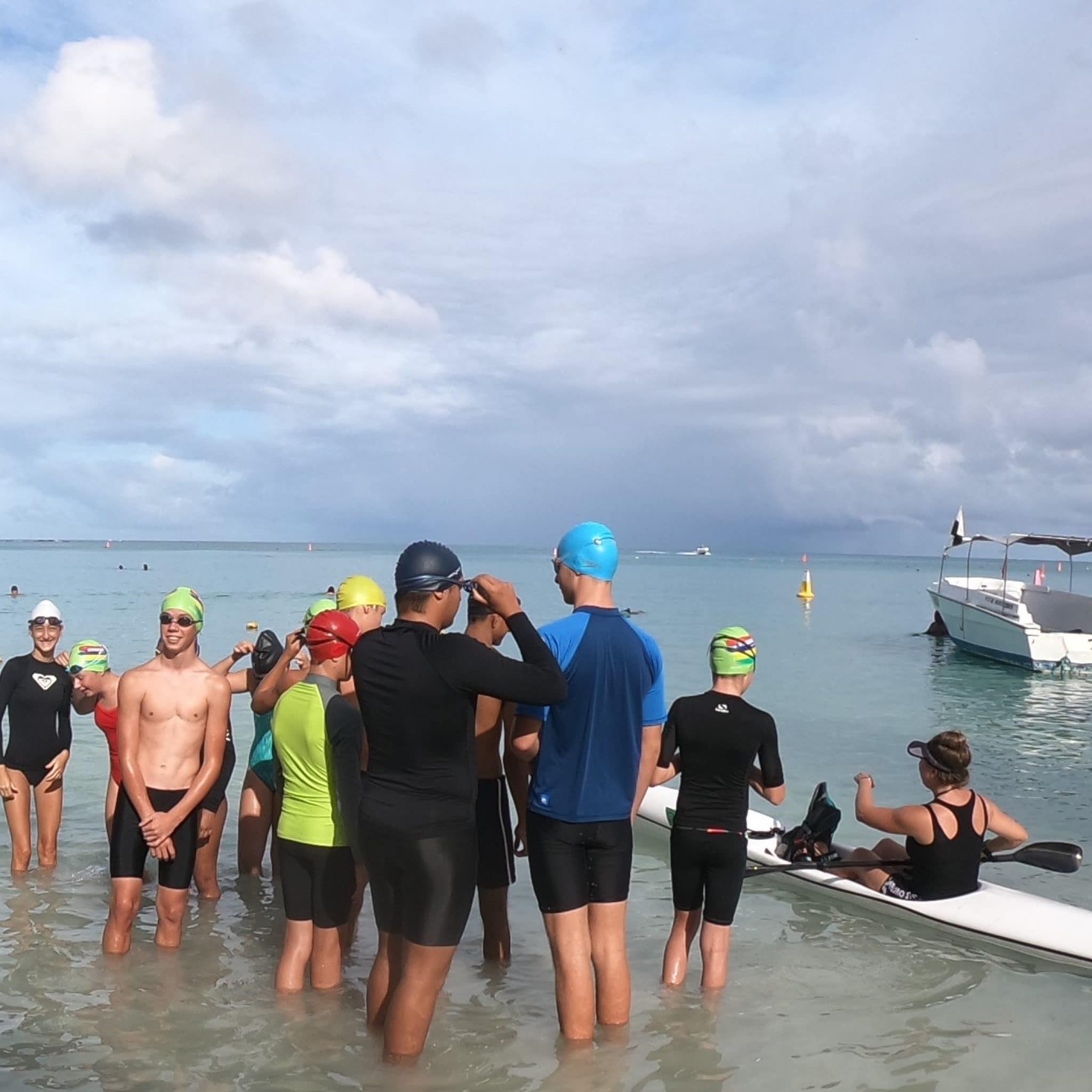
In 1997 a single swimmer circled Mauritius alone. He was not young, he was supported only by a boat, and it took him 18 days. He did it to prove it could be done.
In 2020, 12 Students from Northfields International School in La Bourdonais Mauritius are planning to swim around the Island in only 8 days, and they are doing it to generate interest in the things that matter to them. Why you ask? Are they crazy? Its 180 km.
Surely their parents won’t allow this, I thought, and I went down to the beach to meet the team and make a video of them on their first day of training. Unbelievably the parents who are all Mauritius residents, applaud their enterprise. It’s being cleverly coached by teachers Murray Botha and Jordan Peek who have planned a support team of canoeists and boats.
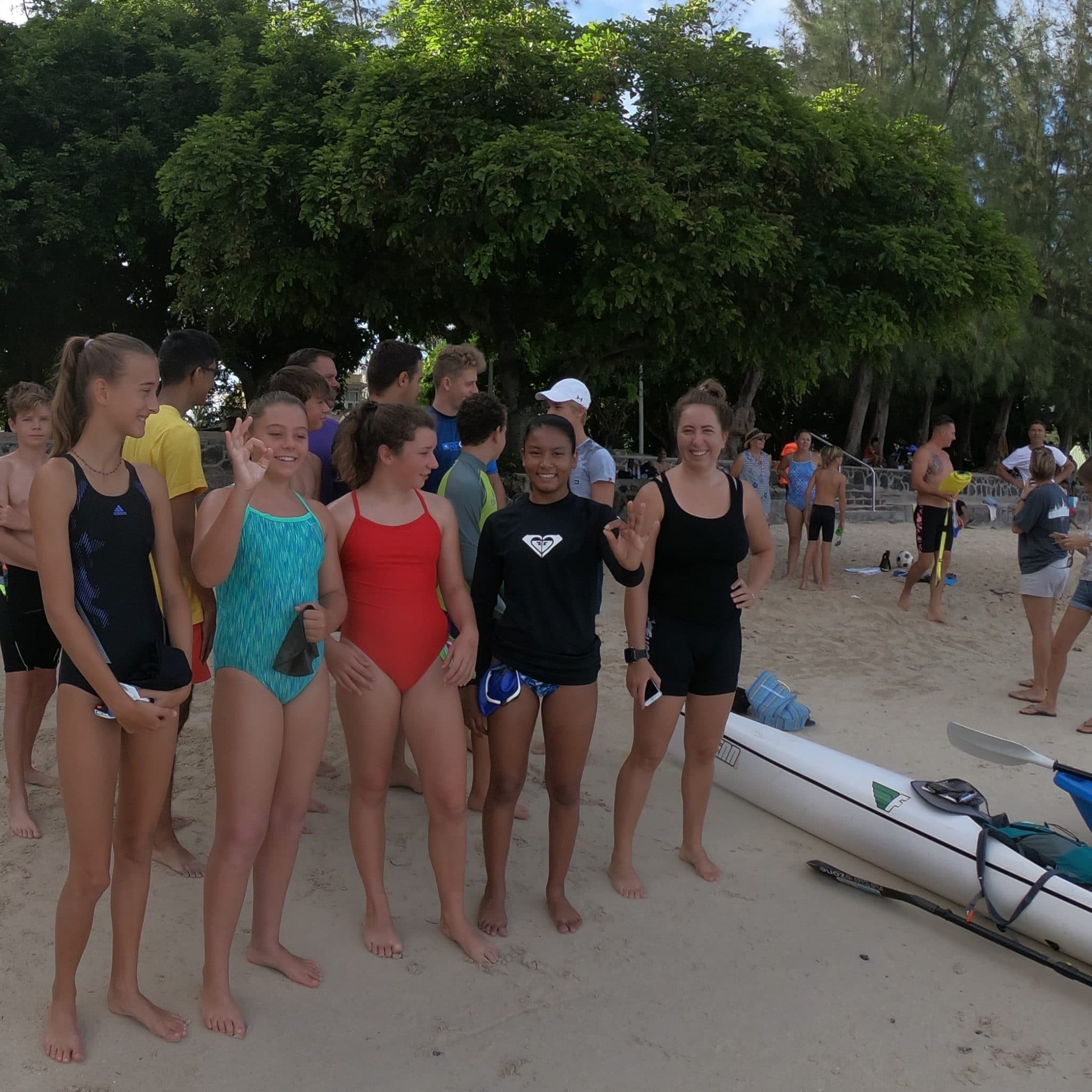
The Team of 12 swimmers
Inspired by Murray Botha and Jordan Peek, two teachers at the Northfields School, 12 Students between the ages of 12 and 17 are swimming around Mauritius. Accompanied by 4 x 2-man canoes, a powerful support team and a boat, the swimmers will make the swim in relays, changing swimmers every 30 minutes, and swimming 20 km per day over 9 days.
These Students watch plastic bottles being dumped out of the windows of buses and cars into the streets of Mauritius in their suburbs, and they see them being carried down-stream into the ocean.
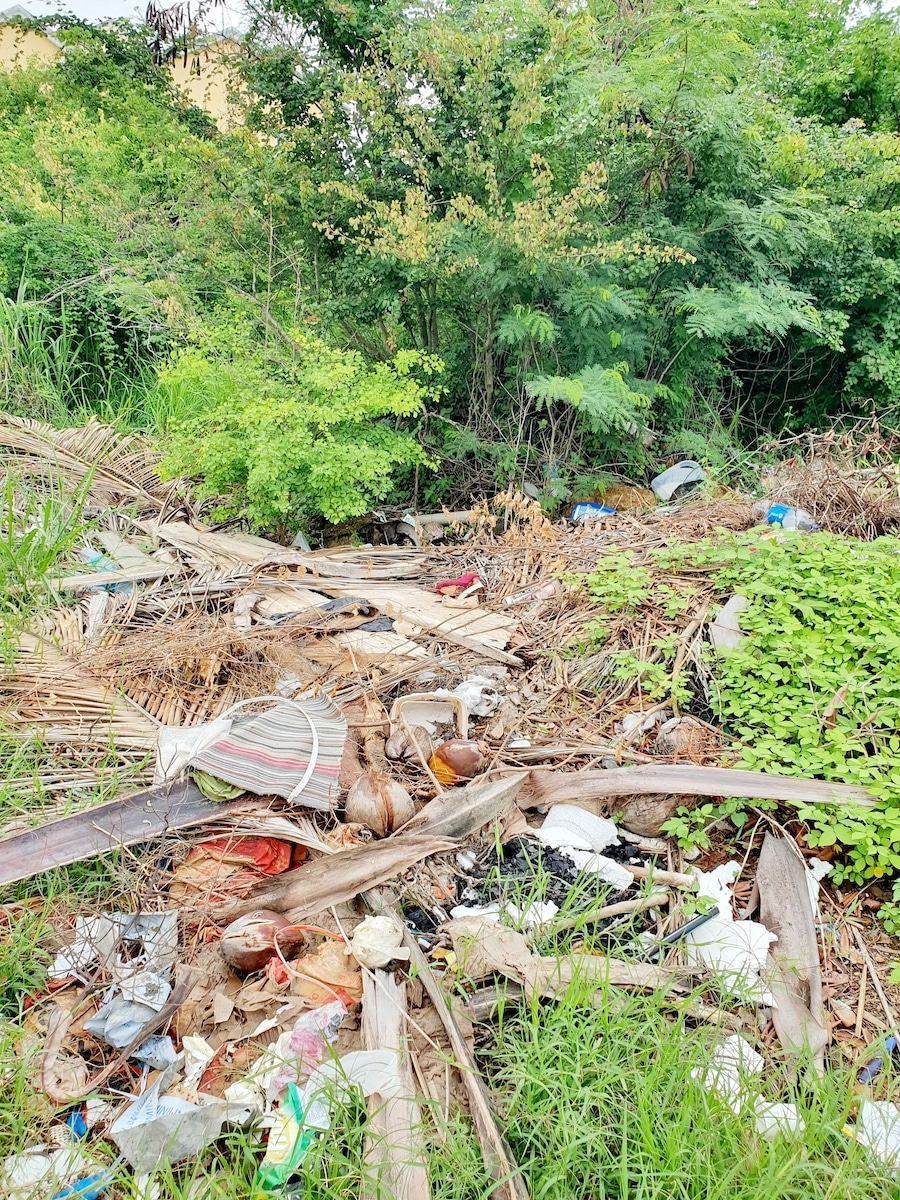
Illegal trash dumping
They are also deeply concerned about the conservation of Mauritius reefs and about overfishing. They want to draw attention to both land based and marine conservation.
They asked me what conservation issues were faced by the diving industry in Mauritius, and I was happy to oblige.
https://youtu.be/Ajlkbrq8QSQ
We have had the most amazing diving for the last 3 years, with spectacular new corals and thriving and abundant fish life. Mauritius wreck diving is world class. Shark diving is superb, with deep walls and Cathedral like canyons where they lazily circle in the washing machine currents.
Now for no apparent reason the turtles have left Turtle Rock, we no longer see huge shoals of tuna and marlin and billfish are no longer around and although the sharks are still plentiful around their normal habitat, we no longer see the baby white tips on the inshore reefs. Trying to find out why, I looked into the Mauritius Ministry of Fisheries website, and was horrified to find recipes on how to clean reef fish so they could safely be eaten.
This list explains which of the reef fish must be treated before being eaten, among them a huge number of rare and endemic reef fish, all caught under license from the Mauritius Government.
One dreadful article explains how to clean and serve a Hawksbill turtle, listed as toxic unless treated, although these endangered turtles are now fully protected under recent legislation.
The legacy of French cuisine seems to be impacting the reefs, although the Island was British for over 150 years. Fortunately, most tourists are well aware of the need to protect reef fish, and most of the resorts are discreetly refusing to serve them.
The pic below shows the fish that can be caught under license in Mauritius- Groupers, Unicorn fish Yellow edged lyre tails, Porcupine fish, wrasses… all reef fish.
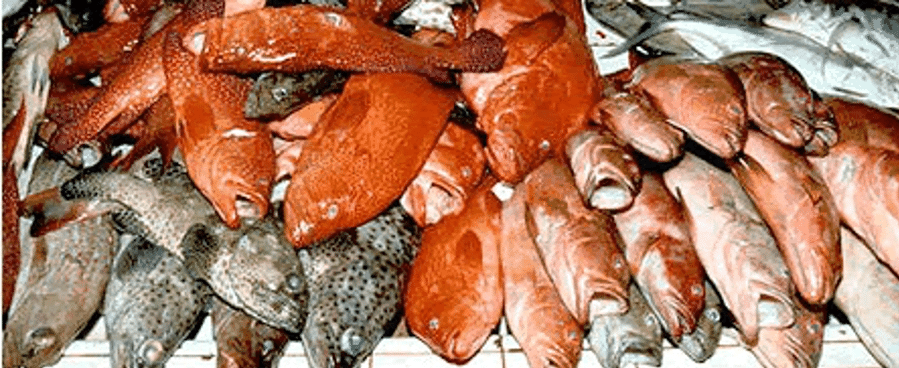
Reef fish on display on Ministry of Fisheries website
Tragically, the Fisheries Ministry does not seem to know the difference between pelagic commercial fish passing through in shoals and territorial reef fish. They also appear to have licensed and registered a shark exporter as seen on their web pages, despite the fact that they have signed an international protocol for the protection of sharks.
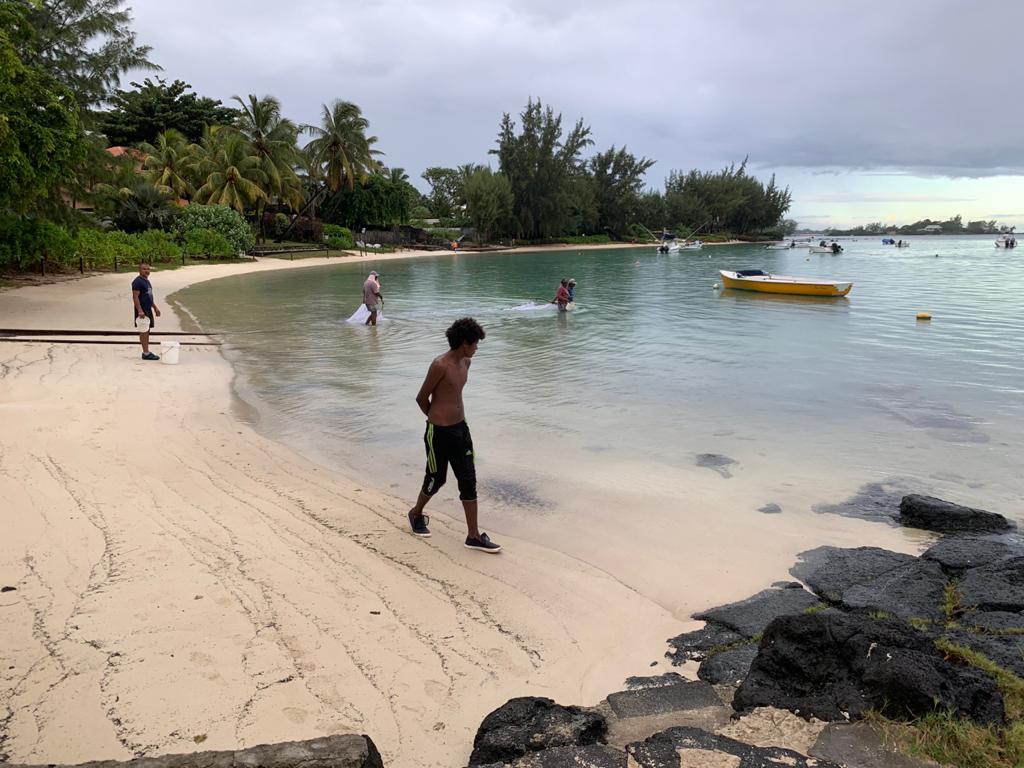
Small mesh net fishing
When I spoke to the students, each one had a different perspective on the swim, and all of them were completely committed. Illegal fishing with small mesh nets was a huge concern, as we all see this when we walk the beaches early in the morning.
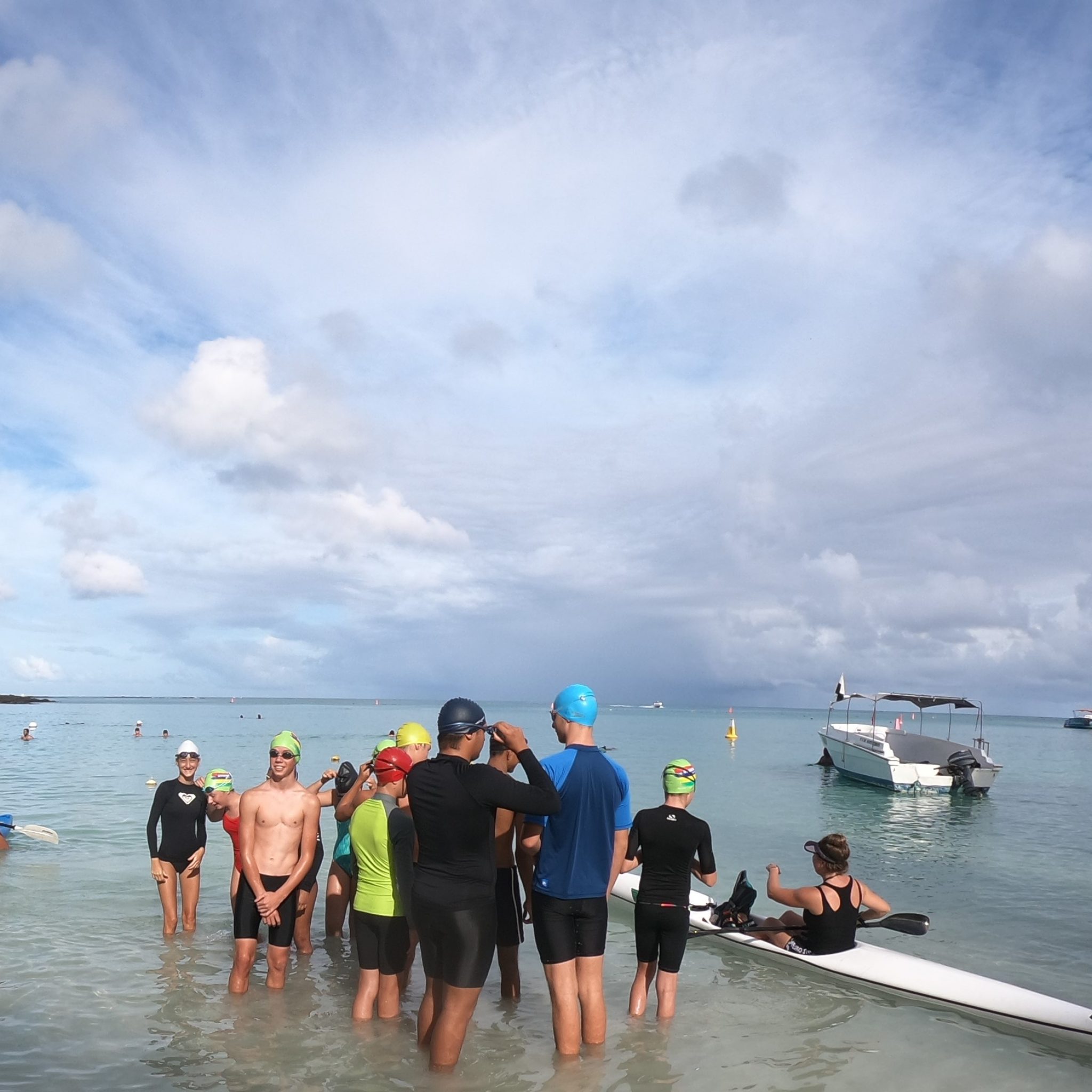
The Island Swim Team with Jordan and Murray on their first training day
The teams of swimmers and paddlers will stop at various resorts on the lagoons overnight, and The Attitude Hotels Group of resorts, who have a reputation for implementing conservation practices in all their resorts, have volunteered to assist by providing accommodation in their resorts for the swimmers.
The conservation objectives will be presented every 20 km at the overnight stops. Diving centres along the route will meet the teams each evening.
With the uncertainty that oppresses a tropical island diving destination when the world goes into lockdown and planes are grounded, we are all concerned about the impact of the COVID 19 virus on international tourism in Mauritius.
The School Sports Department is planning a comprehensive scuba diving training program in conjunction with local dive centres. The local French school too has been approached by one of the diving centres in the area to allow training of their students.
Euro Divers at Club Med has offered its diving centre for training school Students, and Sun Divers in the West has undertaken to train school Students in the Flic en Flac area..
And taking advantage of the PADI COVID 20% discount on courses, many parents are keen to get their Students diving.
So, the 2020 Mauritius Island Swim is the ideal way to kick-start a new attitude to both conservation and diving in Mauritius.
- Words: Jill Holloway
- Copyright: Ocean Spirit www.osdiving.com 2020
- Images: Jill Holloway; Thomas Vignaud and the Mauritius Ministry of Fisheries
News
Book Review: Fire on Monroe Bravo by Fred Lockwood

Fire on Monroe Bravo is the latest book in the Jack Collier series by Fred Lockwood. Our story begins with our lead characters, Jack and Sandro, owners of Marine Salvage & Investigation Company, arriving on the Monroe Bravo Oil & Gas Platform in the North Sea. Having secured a contract for their vessel the MV Stavanger to act as support ship to the platform for TransGlobal Oil, our protagonists are on a celebratory visit.
However almost as soon as they arrive a series of explosions rock the platform, causing huge damage, loss of life and the very real danger of a massive human, ecological and financial disaster.

As the danger mounts for both our heroes and the surviving workers, Jack and Sandro will have to escape the inferno, all while trying to save the platform and the men still trapped unable to help themselves.
The disaster sets the scene for the unfolding story lines following the fate of the platform and our main characters, the police investigation into a suspected terrorist act and the actions of TransGlobal Oil as they attempt to navigate the pubic outcry and financial repercussions.
In his eighth book, Fire on Monroe Bravo, Fred Lockwood delivers an explosive thriller, with plenty of above and in-water drama, and our heroes fighting for survival, what more can you ask for?
We thoroughly recommend this read and look forward to the next in the series. For more information about his book series, you can check out the reviews of his previous books here on Scubaverse.
- Title: Fire On Monroe Bravo
- Author: Fred Lockwood
- ISBN: 979-8325324536
Available in a paperback version and for Kindle from Amazon and book stores.
Blogs
Alonissos: The complete diving destination (Part 1)

In June we were incredibly fortunate to be invited to dive in Alonissos, a small Greek Island in the Sporades island chain located in the North Aegean Sea. While I have long been a big fan of the Greek Islands as a great holiday destination, I had not had the opportunity to do any diving on previous visits and Mike and I were extremely excited to see what Alonissos had to offer both above and below the surface!

The Sporades are easily accessible via the airport in Skiathos (the first island in the chain), which is served by Jet2 flights from all major UK airports from May through October. Numerous ferries and charter boats make island hopping from Skiathos Town a breeze. After an hour boat ride, the picturesque port of Patitiri was a wonderful introduction to Alonissos, where we were met by our gracious hosts Kostas of Albedo Travel and Dias of Alonissos Triton Dive Center. Mike and I were delighted to be staying at the Paradise Hotel, aptly named for its stunning views over the sea and great location for walking to the waterfront.

Alonissos is beautifully situated in the National Marine Park of Alonissos and the Northern Sporades, the largest marine protected area in Europe. The surrounding seas offer fabulous marine life, including incredibly rare species such as the Mediterranean monk seal. They boast deep walls covered in gorgonians and sponges, stunning topography with caverns, swimthroughs and pinnacles, and the first accessible ancient shipwreck from 500BC!

In locations where historical sites have been reported, the waters are largely restricted, but with collaboration between government, underwater archeologists and dive centres, incredible underwater museums are being created for a truly unique diving experience. Alonissos is home to the first of these, the Ancient Shipwreck of Peristera Accessible Underwater Archeological Site. The chance to dive into history (along with reports of healthy reef life and amazing underwater topography) meant Mike and I were keen to get in the water.

Our introduction to the diving around Alonissos was at the Agios Georgios Pinnacles, in the channel between Alonissos and Skopelos. This fantastic site was named “The Chimney,’ and proved to have a huge amount to see. We got to a decent depth here (over 25m), and marvelled at a colourful reef wall with a wonderful swim through whose rocky walls were absolutely covered with life. As well as brilliant topography there was no shortage of macro life here. We saw numerous nudibranchs, five different species in total. The second dive at Mourtias reef nearby was a shallower dive along a nice wall with lots of crevices. Several moray eels and grouper called this site home. We enjoyed looking in the crevices for lobster and smaller benthic life, such as cup corals and tunicates.

Our itinerary allowed us two dives a day with afternoons left to explore the island with our hire car and evenings to enjoy the famous Greek hospitality. This proved to be a lovely mix of in-water and land based diversions.

The next days diving to the Gorgonian Gardens and Triton’s Cave was to be even better! These two stunning sites are nothing short of fabulous. The Gorgonian Gardens was a deep wall near to the Agios Georgios islands. The ever-present currents in this deep channel meant that the sea life was amazing … the namesake Gorgonian sea fans dotted the wall at a depth of 30 to 50 meters, getting ever larger the deeper we went. Above 30m was by no means less beautiful, with sponges, corals, scorpionfish, moray eels and some rare and colourful nudibranchs.

The second shallower dive of the day was to Triton’s Cave or the Cavern of Skopelos, on the east side of that island. The spectacular rock formations had wild striations both above and below the water making a truly epic topography. The cavern entrance was at 14m, and big enough for a buddy pair, winding up to 6m and passing two beautiful windows out into the blue. Emerging from the cavern, the light at the shallower depths and the incredible rock formations made for a fantastic gentle swimming safety stop and we all surfaced by the boat with massive grins.

Check out our next blog :Alonissos: The complete diving destination (Part 2)” to hear about our amazing dive on the 2500 year old Peristera Wreck!
Thanks to:
Alonissos Triton Dive Center https://bestdivingingreece.com/
Albedo Travel https://alonissosholidays.com/activities/
Paradise Hotel https://paradise-hotel.gr/
Alonissos Municipality https://alonissos.gr/en/
-

 Blogs2 months ago
Blogs2 months agoDiving With… Nico, Ocean Earth Travels, Indonesia
-

 News1 month ago
News1 month agoMurex Bangka Announce New Oceanfront Cottages & Beachfront Dining
-

 Blogs2 months ago
Blogs2 months agoA new idea in freediving from RAID
-

 Marine Life & Conservation1 month ago
Marine Life & Conservation1 month agoIceland issue millionaire whale hunter a licence to murder 128 vulnerable fin whales
-

 Marine Life & Conservation2 months ago
Marine Life & Conservation2 months agoThe Shark Trust Great Shark Snapshot is back
-

 News3 months ago
News3 months agoCharting New Waters; NovoScuba Goes Global with the Launch of their Revolutionary Dive Training Agency!
-

 Gear News1 month ago
Gear News1 month agoNew Suunto Ocean – a dive computer and GPS sports watch in one for adventures below and above the surface
-

 Marine Life & Conservation Blogs2 months ago
Marine Life & Conservation Blogs2 months agoBook Review: Plankton













